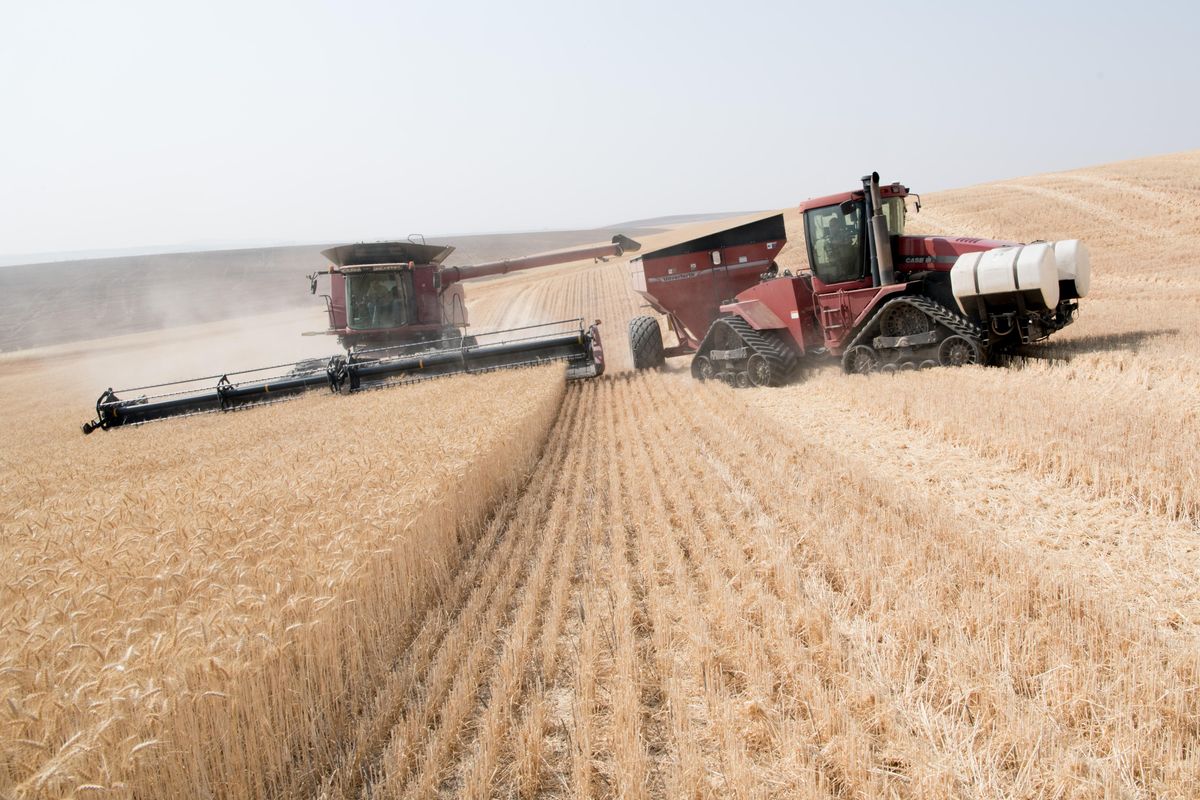Prices, production looking good for Washington wheat despite uncertain markets
Tom Zwainz, left, and his son Joel Zwainz harvest wheat on Wednesday, Aug. 22, 2018, at their farm in Reardan, Wash. (Tyler Tjomsland / The Spokesman-Review)Buy a print of this photo
REARDAN, Wash. – Belching clouds of orange dust, the massive red machines crawled along the hillsides north of Reardan eating endless rows of amber stalks.
It’s one of the Northwest’s iconic scenes: The end of summer marks the time when Eastern Washington farmers transform rolling landscapes of wheat into hundreds of millions of dollars’ worth of grain that flows from trucks, trains and barges into foreign ports.
And despite deepening uncertainty about global markets and a looming trade war over tariffs, wheat farmers are having a good year, said Derek Sandison, director of the Washington State Department of Agriculture.
“It’s a definite improvement,” Sandison said. “Coupled with better prices and an above-average yield, it’s more positive than it’s been lately.”
As result of dry weather in Russia, Australia and the European Union, the prices for wheat have remained at or above the cost of production. Weather also cooperated. With the vast majority of local wheat grown dryland, or without using irrigation, the yield is coming in about 25 percent higher than average, Sandison said.
Most of the wheat has already been harvested in the warmer areas of the region. But about half of the wheat planted around Spokane had yet to be cut by the end of last week. And with the price hovering somewhere near $6 a bushel delivered to Portland, farmers should come out ahead in the end, Sandison said.
But uncertainty over international agreements will eventually plow headlong into the industry, said Mike Miller, chairman of the export market development organization U.S. Wheat Associates. Miller also farms wheat and other crops both south and north of Ritzville.
Good prices have “softened the blow, short term,” he said. “This whole trade conversation is long term. If you lose market share, it will take 20 years to get them back … even after all these other problems go away.”
Family farm
Tom Zwainz, 61, started kicking up dust in these fields at the age of 13. He’d drive a grain truck as far as the dirt road, where his grandfather would take over and haul the truck into town.
Zwainz graduated from the University of Idaho and spent a few years as a banker before he returned in 1983 to the ground his great-grandfather started tilling in 1887.
“I don’t go to work,” he said as he drove a combine Wednesday. “If you do what you love, it’s not really work. Some years you don’t get the rain or the prices and it’s a little tougher. But I enjoy what I do.”
He and his son, Joel Zwainz, 30, have been harvesting wheat since mid-July on the ground, about 4,000 acres, that they farm from near Colfax to north of Reardan.

About 25 percent of their crop is soft white winter wheat, which was planted last October. Another 20 percent is hard red winter wheat and another quarter of the crop is hard white spring wheat. The remainder is hard red spring wheat, which is planted in April. Zwainz also mixes in some spring-planted canola and chic peas, depending on the market.
“Soft white wheat is primarily grown in the Pacific Northwest. This is the ideal climate for it,” he said. “In our export markets, it’s probably the best moneymaker.”
On the dryland farm near his home, Zwainz said he averages about 35 bushels per acre in a normal year. “We were getting upwards of 60 to 70 bushels per acre in some areas,” he said. “ It will be interesting to see … what the crop has done.”
Sandison, the state ag director, said about 92 percent of all the wheat grown in Washington is exported. While the numbers for 2017 are not yet finalized, local farmers produced about $650 million worth of wheat in 2016.
“We are so trade dependent,” Sandison said. “With respect to wheat, most of our trading partners are Pacific Rim countries.”
Fears down the line
With one of his first trade actions, President Donald Trump pulled the United States out of the Trans-Pacific Partnership after years of negotiations by producers, like Miller and Zwainz, who had traveled overseas to build those relationships.
In 2017, Washington’s leading export markets were Japan, the Philippines and Indonesia. However, China alone imported some $67.5 million worth of wheat last year, said state agriculture department spokesman Hector Castro.
“The greatest concern is the Japanese market,” Sandison said. “They are a major buyer of our wheat. This doesn’t just happen overnight.”
As a result of pulling out of the Trans-Pacific Partnership, current members Australia and Canada will continue to enjoy a reduction in tariffs while the tariffs imposed on U.S. goods will remain unchanged.
“Within three years, we will see a serious disadvantage,” Sandison said.

Washington does have some trading advantages, such as the quality of wheat and the fact that it’s a major producer of soft white wheat. Miller said if Australia or Canada moves in to take the U.S. market share with China or other countries, that could open other markets for Washington growers.
“That does leave a vacuum that the U.S. could fill in,” Miller said. “But you may have to fill that with much lower wheat prices.”
Zwainz served several years on the Washington Grain Commission, including working with Miller. Zwainz traveled to Asia, South America and Egypt on trade missions.
“I have to chuckle at the trade situation,” he said. “This trade thing has been going on for years. It takes bad weather in a couple of countries. For us to get good prices, someone else has to suffer.”
Pay to play
Zwainz said it costs him roughly $5.50 to produce a bushel of soft white wheat, which was within a few cents of what he was getting paid per bushel at the elevator in Reardan.
“The prices have come back up significantly,” he said. “They are almost $1.30 a bushel over what they were paying last year. It still takes an above-normal crop to meet our cost of production.”
If you factor in the costs of equipment replacement and socking away money for retirement, the cost per bushel is somewhere closer to $9, he said.
Asked how he can continue to operate when the price barely covers costs, he said it takes planning, budgeting, good weather and good luck.
“Fortunately for us, the winter wheat is above average. So, hopefully, we covered expenses there,” he said. “I’m fortunate that we do a fair amount of custom work on the side.”

Miller, too, said there are no easy answers in farm economics. They face the same costs and income issues as anyone. “It’s just on a super-sized scale. There are just more zeroes at the end of the line.”
Miller said the cost-per-bushel estimates are based on a 10-year average. So anytime farmers can produce more wheat than they expect, it provides the extra income to keep the operation afloat.
“So it’s not all gloom,” he said. “If you have equity and you have kept the debt to a minimum, you can tighten the strings and buckle up and make it through a bad year.”
Farmers also have the option of paying $4 to $15 per acre for crop insurance. If they face drought or the price of the commodity drops below a certain point, the government insurance program makes the farmers whole.
“Yes, it’s a subsidy,” Zwainz said. “But the farmer has significant skin in the game through premiums. If there is a drought, the farmer would have an option to protect his crop and income.”
Technology a plus
Zwainz said farmers once relied on memory about what areas of the field needed more or less fertilizer to produce. Now they rely on computers and satellites.
Most crop production companies provide farmers with satellite images that show how well certain crops grow on different areas of their land, he said.
On Wednesday, Zwainz was driving a 2015 Case 8240 combine that he purchased used for $400,000. He said the machine would have cost $600,000 new.
The combine pushes a massive 40-foot header that rotates and draws the wheat into the bowels of the combine where it uses spinning agitators and compressed air to separate the wheat from the chaff. The kernels are then fed into the combine’s internal hopper, which holds about 400 bushels of wheat before it must be unloaded.
As he drove the 480 horsepower combine, Zwainz kept an eye on a computer screen that showed him everything from how many bushels per acre he was harvesting, to engine speed and even the moisture content of his grain.

The moisture reading showed his wheat was at 8.5 percent. Buyers at the grain elevator “don’t like it if it comes in above 12 percent,” he said. “It doesn’t store well above 12 percent moisture.”
But the computer also had a GPS map that remembered the yield so that Zwainz can go back and use that information to determine which areas of the field need more fertilizer or less. He combines that information with the satellite images to figure out a plan.
When the tractor hits the field in October or April, it drills the seeds into the ground and applies fertilizer, based on the computer data, all at once.
“We are putting the same amount of fertilizer, but we put more on lower-production areas and less on higher-production areas,” he said. “It’s a little more scientific. The cost of that technology has come down significantly.”
But the cost of maintaining the new equipment has not. Zwainz said he has about 20 pieces of equipment that have engines. If he replaces one machine a year, that still means his last one will be 20 years old before he can upgrade.
“If you have stuff that is 5 to 10 years old, it’s a lot easier to ride another five years than if something is 25 years old,” he said.
Just last week, the 1999 Case 2388 combine broke down. It was lost for an entire day as crews replaced a hydraulic hose to the hydrostatic drive. That repair cost $3,300.
While the much larger 2015 combine is newer, its parts cost much more. On the newer combine, the muffler, which lowers exhaust emissions, costs $15,000, Zwainz said. That alone would eat up the farm’s annual budget for repairs.
“If a pulley comes off, we can fix it. But with these new electronics, they have to plug in the laptop to diagnose it,” he said. “Then you are relying on the dealer. With a three-hour travel time, it’s $500 before they even plug in their computer.”
The tradeoff comes in warranties. Most parts have a five-year plan to cover the cost of replacement, he said.
“The costs of these machines are getting outrageous,” he said. “But if you don’t replace stuff once in a while, you kind of get into a death spiral.”
But with an above-average crop and decent prices, Zwainz said he hopes to keep his farming dream alive.
“There is no difference between us and any other business,” he said. “We are more capital intensive where others are more labor intensive. But I think it’s going to be a pretty good year for most people.”










